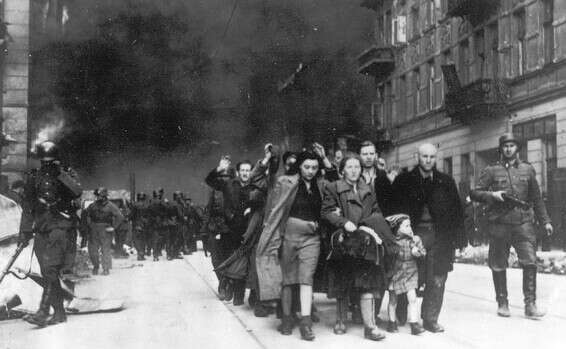EZI members fought in desperate battle with burning Nazi forces in the burning ghetto • Since they were revisionists, decades have been removed from their consciousness some of the heroic story of the uprising • opinion
Deportation of Jews from the Warsaw Ghetto // Photo: IP
At the end of World War II in Europe, Mordechai Shenhavi published a master plan for the establishment of Yad Vashem, the central memory of which will be the Warsaw ghetto uprising. A year after the war, a memorial ceremony was held in the Polish capital, attended by partisans, rebels and other brave people who fought under non-conditional conditions in the Nazis. However, fighters belonging to political and ideological groups other than those of the socialist left - were absent from the ceremony, even symbolically. EZI Fighters - A Jewish military organization, after which a glorious and illustrious chapter in the fight against the Nazis was written during the uprising, was brutally forgotten from memory in the decades that followed.
At the same time, the State of Israel, which was designed in the first years of existence solely in Mapai's image and image, denounced from the Zionist memory the part of the Irgun and Lehi in the fight against the British. They were called the "retirees." But while the modern underground fighters stayed alive, they fought for In order to regain their good name and succeed, the story of EZI fighters could have descended into historical oblivion because a number of individual fighters who survived and sought to tell their story - were deferred.
Twenty years after the uprising, Haim Lazar-Lithuanian completed a comprehensive study that included authentic testimonies and stories about EZI and published them in the book "Warsaw Masada," but encountered an impassable wall of silence. The '77 revolution brought not only a political upheaval, but also a change of concept for all So many issues and areas, but not for EZI: The organization was hidden in people's hearts, buried in archives and libraries behind iron walls and never reached the public's heart.
EZI's story is a marvelous story. It was a fighter underground organization set up during World War II by Betar and Jabotinsky members, culminating in the end of Passover on April 19, 1943. On that day, German soldiers entered the ghetto. In armored vehicles and cannons. Opposite them stood several hundred young Jews equipped with low arms. They fought for ten days.
The main battle - the "battle for the flags" - took place in Moranovsky Square, between forces commanded by EZI commander Powell Frankel, who waved one of the houses on the roof of the Zionist flag and the Polish flag, and German soldiers commanded by General Jurgen Stroop. The Germans dropped the flags and killed the vast majority of the fighters.
The late Prof. Moshe Arens, who passed away this year, was an exceptional politician and diplomat, but EZI's forgetfulness did not give him a rest. His insistence on discovering the truth, which is noteworthy in its own right, revealed the humility of those who are regarded as official historians of the Holocaust.
Although every field seems to be thoroughly explored and the soul of every research institute, Arnes addressed the subject to Holocaust historian Yehuda Bauer, who told him while working on the book that "you will not find anything new. After so many years, anything related to rebellion The Warsaw ghetto is already well known to all, including the participation of Betar members.
Bauer offered Arnes to contact historian Israel Gutman, who admitted that the Betar youth did not receive the credit for the uprising, but there was no record of it, and also insisted that "she couldn't find anything new."
But Arnes did not give up, persisted, and even found evidence from authentic sources. One of them was a "Stroop report" compiled by the SS General, who headed the Nazi forces sent to destroy the ghetto, stating that Betar youths were a major part of the uprising. In doing so, he also completely contradicted the studies of distinguished professors like Bauer.
In 2009, Arnes completed the full study and published it in the book "Flags Over the Ghetto," putting the events in perspective. Thus came to an end another episode that shows how much the State of Israel changed for the better when the truth came out. There are quite a few stories to be uncovered but the wall of silence in the open, diverse and pluralistic era has been shattered.
Shortly before the outbreak of the uprising, Frankel said in a meeting with his fighters: "Friends, we will die prematurely, but we will not be condemned to doom. We will live as long as Jewish history continues to live."
77 years have passed since then and we will not forget his exciting words.

